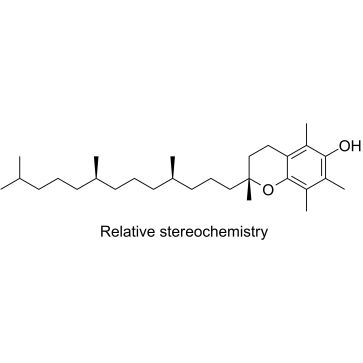2074-53-5
| Name | d-.α.-Tocopherol |
|---|---|
| Synonyms |
2,5,7,8-Tetramethyl-2-(4,8,12-trimethyltridecyl)-6-chromanol
IRGANOX E 201 3,4-Dihydro-2,5,7,8-tetramethyl-2-(4,8,12-trimethyltridecyl)-2H-1-Benzopyran-6-ol DL-TOCOPHEROL DL-PHYTOGERMINE A-TOCOPHEROL DL-VITAMIN E DL-PROFECUNDIN 2H-1-Benzopyran-6-ol, 3,4-dihydro-2,5,7,8-tetramethyl-2-(4,8,12-trimethyltridecyl)- 6-Chromanol, 2,5,7,8-tetramethyl-2-(4,8,12-trimethyltridecyl)- 2,5,7,8-tetramethyl-2-(4,8,12-trimethyltridecyl)chroman-6-ol DL-α-Tocopherol 3,4-Dihydro-2,5,7,8-tetramethyl-2-(4,8,12-trimethyltridecyl)-2H-1- -benzopyran-6-ol Ido-e |
| Description | rel-α-Vitamin E (rel-(+)-α-Tocopherol) is a vitamin with antioxidant properties and also a mixture[1]. |
|---|---|
| Related Catalog | |
| In Vitro | Vitamin E is a lipid-soluble, chain-breaking type of antioxidant present in human blood. Vitamin E works as a free radical scavenger and has the primary function of destroying peroxyl radicals. Thus, it protects long-chain polyunsaturated fatty acids (e.g., cell membranes or low-density lipoprotein cholesterol) from oxidation or destruction. Its association with vitamin C is of great pathophysiological importance, because inhibition of lipid peroxidation by α-tocopherol occurs through its conversion into an oxidized α-tocopheroxyl radical, which in turn is regenerated to α-tocopherol through reduction by redox-active reagents[1]. α-Tocopherol can inhibit the recruitment of lymphocytes and eosinophils[1]. |
| In Vivo | In order to longitudinally relate vitamin E status, evaluated by means of α- and γ-tocopherol measured in erythrocytes membranes, to inflammatory state and oxidative stress by means of total antioxidant capacity of plasma and lipid peroxidation biomarkers, and to assess its association to hard long-term outcomes (e.g., overall and cause-specific graft and recipient loss), and to be able to likewise account for liver, lung, and heart transplant recipients[1]. |
| References |
| Density | 0.9±0.1 g/cm3 |
|---|---|
| Boiling Point | 485.9±0.0 °C at 760 mmHg |
| Melting Point | 3ºC |
| Molecular Formula | C29H50O2 |
| Molecular Weight | 430.706 |
| Flash Point | 210.2±24.4 °C |
| Exact Mass | 430.381073 |
| PSA | 29.46000 |
| LogP | 11.90 |
| Vapour Pressure | 0.0±1.2 mmHg at 25°C |
| Index of Refraction | 1.495 |
| Storage condition | 2-8℃ |

